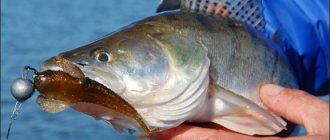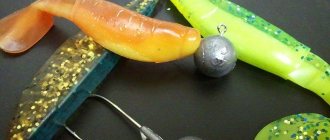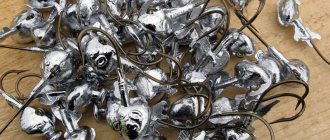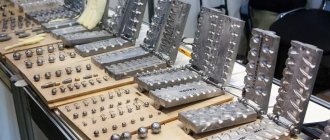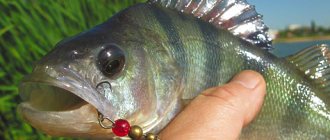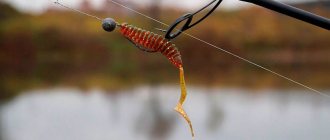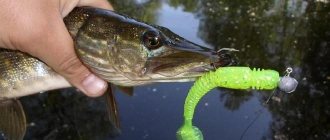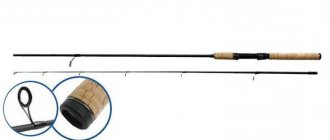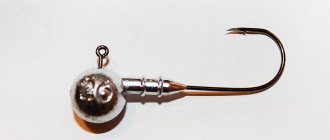Tips for choosing a jig sinker
- For fish, a bait that lowers slowly during the pause phase of the retrieve is more attractive, so the weight of the head weight should be as small as possible.
- The less the load weighs, the fewer snags there will be!!!
- The jig head should allow the bait to sink to the bottom so that the fisherman can feel it with the tackle.
- Remember that not only the sinker has a certain weight, but also the bait itself with the hook, as well as accessories that can be used in the case of installation using an eared sinker or a “bullet”.
Equipping a vibrating tail with a double
Rigging a vibrating tail on a double requires selecting a hook with a long shank. Attaching a vibrating tail to a jig with this type of double greatly simplifies the task.
As when mounting on a single type of hook, we determine the point for piercing the bait, only now this will not be the point where the tip exits, but the place where the double ring is inserted into the body of the bait, and the point will not be on the back, but on the side. Slightly spreading the hooks of the double, we pierce the fish through the side with one hook and string the silicone along the entire fore-end. As a result, it will turn out that the vibrating tail will hang with its back between the two hooks of the double. Then, pressing the ring into the body of the bait towards its mouth, we thread the silicone through until the fastening ring comes out of the fish’s body. The installation is almost complete, all that remains is to straighten the nozzle to the length of the entire shank of the hook so that it receives its original geometric dimensions and is not subject to deformation.
Important! A deformed bait has a noticeably more negative effect on the quality of its play when fishing.
In most cases, deformations of the silicone bait arise from an incorrectly determined puncture site and from an incorrectly selected length of the shank of the vibrotail hook. In case of sluggish bite, uncertain bites and frequent gatherings, it is reasonable to equip the bait with a jig using a tee in the installation. This installation option allows you to increase the chances of catching a cautious and fastidious predator.
Jig heads review
In the case of a weak current, it is necessary to add another 2-3 g to the indicated weight indicators, with an average one – another 4-6 g, and in case of a strong current, it must be multiplied by 2.
Note that these ratios are not at all strict; every jig fishing fan should experiment with the weight of the weight heads, try different options in practice, paying attention to the reaction and activity of the fish, the degree of sensitivity of the gear, and the efficiency of the retrieve.
In this case, an individual compromise is needed, in which the load would not sink quickly, but not too slowly, and the tackle would feel good.
Another factor that influences the choice of load weight in current conditions is the thickness of the cord.
The thicker the cord, the stronger the force of the current and wind acts on it, that is, the thicker the cord, the greater the weight of the jig head should be.
Selecting the weight
The weight of the jig head must be selected in such a way as to achieve the desired speed of the bait falling to the bottom. As a rule, with a classic step retrieve, the jig head should fall from 2 to 4 seconds.
For fishing in ponds
For fishing in small standing reservoirs you will need the following weights of weight heads:
| Depth | Weight |
| up to 2 m | 2-6 g |
| 2-4 m | 5-10 g |
| 4-6 m | 8-12 g |
| more than 6 m | 12-18 g |
On large lakes and reservoirs
When fishing on larger bodies of water, slightly heavier jig heads are needed. Below is a table of correspondence between the depth of the reservoir and the weight of the heads:
| Depth | Weight |
| up to 2 m | 4-8 g |
| 2-4 m | 6-12 g |
| 4-6 m | 10-14 g |
| 6-10 m | 14-20 g |
| over 10 m | 18-30 g |
On the rivers
For fishing in the current, you will need heavier jig heads than those used in still waters, since the flow of water pushes the bait upward, and the spinner, in order not to lose contact with the bottom, needs to weigh the bait .
The choice of a specific weight depends on the strength of the current and the activity of the fish; in most cases, it is advisable to choose such jig heads so that the time the bait falls on the step is the same 2, 3 or 4 seconds. For most medium and small lowland rivers, when fishing at depths from 2 to 5 meters, weight heads weighing 8-16 g are suitable. The stronger the current, the heavier and more compact sinkers will be needed .
And do not forget that the key to success in fishing is knowledge of theory, supported by practice . After all, a truly clear understanding of which jig head should be used in what conditions comes with experience.
Some subtleties of selecting hooks and jig heads in the video for beginner fishermen.
Source: fishcave.ru
How to increase the casting distance of jig baits
You can increase your casting distance in various ways.
First of all, this is done by moderately increasing the weight of the jig head. Also pay attention to the shape and dimensions of the bait: narrower silicone baits fly further than their bulky, wide-bodied counterparts.
The casting range will be greater if a hinged mounting is used.
Sometimes, for various reasons, it is necessary to reduce the weight of the sinker. First of all, such a need may arise in order to reduce the speed at which the bait falls during pauses during retrieval.
Of course, such procedures will negatively affect the casting distance and reduce the rate of fishing, but often the bait becomes more attractive to the fish, since its movements become more natural.
Tee equipment
To equip vibrotails with triple hooks, you will need additional unpretentious equipment in the form of a metal or plastic tube with a diameter of no more than five millimeters. The length is enough to be 2 cm. The tube should be one and a half times the thickness of the silicone bait being mounted. This device is needed to make a through hole in the side of the vibrating tail body for mounting a tee.
Important! The hole should be optimal in diameter based on the size of the tee. A small hole will not allow symmetrical installation of the tee hooks, and a large hole will increase the play of the tee during wiring and will deteriorate the quality of the nozzle’s play.
As in the first installation diagrams, markings are made to determine the point of the required hole. The length of the forend of the tee, excluding the loop for fastening, will be our main guideline. We pierce the vibrating tail with a previously prepared tube, since silicone is a pliable material for these manipulations. Next, in the hole made towards the mouth of the fish inside the body of the bait, we thread the triple hook through the front with a fastening ring. Stretching the hole previously made with a tube, we transfer the first tip of the tee to the opposite side of the artificial fish.
We pierce the back with the second sting through the same hole, bringing the tip parallel to the back of the silicone, and leave the third hook without any manipulation. In principle, the installation of the vibrating tail on the tee can be considered complete. The disadvantages of this installation are its rather low cross-country ability in fishing areas with vegetation. The best option for using silicone baits on tees is in clean areas of the reservoir.
Tungsten weights
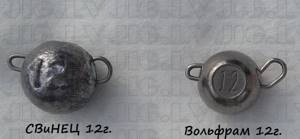
The casting distance is also affected by the shape of the bait and its aerodynamics. It follows from this that the lower its air resistance, with the same weight, the better and the farther it will fly. Therefore, tungsten jig weights were created. Tungsten is heavier and much harder than lead, making it more effective than lead. With the same weight as lead, tungsten weights have a smaller volume and fly further.
It is also worth noting that tungsten sinkers sink to the bottom faster, and in some cases this is a disadvantage in jigging.
Types of jig heads
Weight heads can be divided into two large groups: those that are combined with the hook, and those that are molded separately and attached to the offset hook. More common are the first ones, that is, weight-heads cast with a hook. Actually, such products are called jig heads. Outwardly, they resemble heavy, large jigs; are equipped with a ring located at right angles to the shank of the hook, and a lock, which is designed to prevent the soft silicone bait from sliding and turning.
What is a jig in fishing?
Jig in fishing is a fishing technique with which the fisherman, not without the help of bait, taps on the surface of the bottom of the reservoir. The founders of jig fishing were Asian fishermen, whose main industry was squid fishing.
Over the years, numerous modifications to gear and bait have occurred, but the technique itself and its name have reached our time unchanged. Stepped wiring of a certain type is jig fishing.
Predatory fish, or rather most of them, spend a huge amount of time at the bottom of the reservoir. Obstacles and irregularities, of which there are many on the bottom surface, allow predatory fish to ambush and track their prey without being noticed by potential victims.
The use of jig fishing allows the fisherman to explore hard-to-reach places and, importantly, not return home empty-handed.
You can use jigs in fishing for the following types of fish:
- pike;
- catfish;
- zander;
- perch;
- bersh.
These are not all types of underwater predators, but they are the most popular among fishing enthusiasts.
Non-hook jig heads
To catch predators in difficult areas, which are characterized by the presence of many obstacles and an abundance of vegetation, so-called non-hooking baits are used. Of course, no jig head can provide absolute protection against hooks, but some types (spoon, horseshoe, rugby) actually reduce the number of hooks, which is associated with the vertical position of the hook at the stage of the bait falling.
Jig heads such as “banana” or “ski”, which are characterized by an elongated shape, reduce the chance of side hooks.
Also, in order to protect against snags, fishermen often install special homemade “fuses” made of thin wire, which easily bends under the pressure of fish jaws.
Naturally, the use of such a wire structure will slightly increase the number of unsuccessful bites, but there will be much fewer dangerous hooks.
How to properly attach a vibrotail
Silicone jig baits are varied in their shapes and types, and also differ in size and density of the material. All these factors should be taken into account during installation. It’s simply unreasonable to put a silicone bait on a hook, throw it into the water and expect a successful bite. First of all, the fisherman must understand that a vibrating tail can be equipped with different types of hooks: single, offset, double, tee, and this depends on the fishing conditions, the intensity of bites and the type of fish that the fisherman is counting on. The easiest way to attach a vibrating tail is to a jig head.
Important! Select the place where the wide back of the vibrotail transitions into its narrow tail. This transition point should be the point where the hook tip exits the body of the bait.
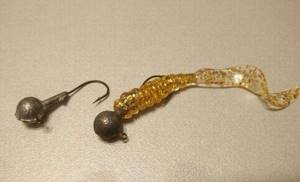
We pierce the vibrating tail with a sting at the location of the mouth of the artificial fish and string its body until the sting of the hook reaches the point of exit to the surface that we have chosen. We bring the point in the back of the artificial fish to half the roundness of the hook of the jig head. This completes the installation.
Important! The hook of the jig head must correspond to the size of the vibrating tail from the mouth of the fish to the point where the tip of the hook is brought to the surface of the back of the nozzle.
DIY jig heads
Casting jig heads yourself is currently very popular, because it is economical, interesting and allows you to create a whole arsenal of a wide variety of weights.
The most difficult thing in this process is making the mold itself for future casting. Both metal forms and simpler ones made of plaster and scrap materials are used.
The weight of the future product can be adjusted not only by changing its dimensions, but also through the use of an alloy of lead and tin. The latter is characterized by lower density, which makes it possible to reduce the weight of manufactured jig heads.
Jig fishing technique for beginners
Beginning jiggers may think that this is a very difficult type of fishing.
Here are some tips to help beginner spinning and jig lovers:
- study the place of future fishing (presence of holes, channel edges, snags);
- a successful (in the fisherman’s opinion) place should be carefully fished;
- try to use more quantity and quality of bait;
- try different types of wiring;
- Do not immediately take heavy weights;
- do not be afraid of being thrown into snags and thickets;
And the most important advice is to never despair. After all, experience is a gainful thing.
